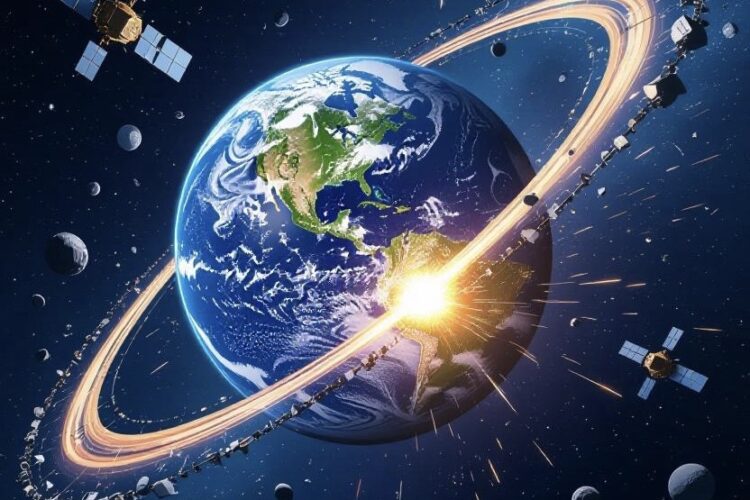The Kessler effect, or Kessler syndrome, is a growing threat in low Earth orbit (LEO) where space debris—think old satellites, rocket parts, and tiny fragments—could trigger a chain reaction of collisions. Proposed by NASA scientist Donald Kessler, this scenario predicts that high object density in LEO leads to more crashes, creating debris clouds that make space unusable. With over 40,000 tracked objects and millions of smaller pieces, risks to satellites and the International Space Station are rising. Causes include satellite breakups, antisatellite tests, and even paint flakes. Mitigation like deorbiting, graveyard orbits, and zero-debris policies helps, while active debris removal, such as laser nudging, shows promise. Without global action, a cascading disaster could block space access, disrupt communications, and halt exploration. Smarter tracking and cleanup are key to keeping orbits safe and sustainable.
Long Version
In the vast expanse of space, where human ingenuity has launched satellites to enable global communication, navigation, and observation, a silent crisis is unfolding. The Kessler effect, also known as Kessler syndrome, describes a scenario where the density of objects in low Earth orbit (LEO) reaches a critical mass, triggering a chain reaction of satellite collisions. This cascade effect, akin to a domino effect or feedback runaway, could render parts of space unusable for generations, creating a lethal halo around the Earth and jeopardizing space exploration, space missions, and space activities worldwide.
First proposed by NASA scientist Donald Kessler in 1978, the Kessler effect warns of collisional cascading, where even minor collisions generate debris clouds that exponentially increase debris populations. As space junk—comprising orbital debris like spent upper stages, mission-related objects, and fragments from explosions—accumulates, the risk of catastrophic collisions escalates. Today, with the proliferation of satellites in LEO, this once-theoretical concept is edging closer to reality, demanding urgent attention to space sustainability and space traffic management.
Sources and Composition of Space Debris
Space debris, often referred to as space pollution, originates from a variety of human-made sources. Fragmentation events, such as accidental break-ups from residual fuel in defunct satellites or solid rocket-motor firings releasing aluminium oxide (Al2O3) particles, are primary contributors. Antisatellite tests (ASAT), like a 2007 demonstration that produced over 35,000 orbital fragments, exemplify how intentional actions can dramatically boost debris flux. Non-fragmentation debris sources include mass loss of surface coatings, paint flakes, and thermal covering material with high area-to-mass ratios, which are susceptible to orbital decay influenced by atmospheric drag, solar wind drag, and lunar perturbation.
Debris fields vary in size, from micrometre-sized dust and micrometeoroid collisions to larger collision fragments exceeding 10 centimeters. The Gabbard diagram, a tool for visualizing orbital evolution post-fragmentation, illustrates how these pieces scatter, forming Kessler rings of debris or a debris belt in populated orbits. In-orbit fragmentation, whether from hypervelocity impacts or internal explosions, further amplifies the problem, creating an exponential increase of debris and elevating spatial density in LEO.
As of 2025, space environment reports highlight that approximately 40,000 objects are tracked by space surveillance networks, with about 11,000 being operational satellites. However, estimates suggest over 120 million smaller debris fragments exist, many untrackable but lethal at orbital speeds. Population growth in low Earth orbit has surged, driven by mega-constellations, which alone required numerous collision avoidance maneuvers in recent periods to evade potential impacts.
The Mechanics of the Cascade Effect
At its core, the Kessler effect is a self-sustained process fueled by critical density. When the density of objects in LEO surpasses a threshold, even minor collisions produce debris clouds that increase collision risk, leading to an ablation cascade. This feedback runaway mirrors a negative externality of unchecked space activities, where initial incidents—like a 2009 satellite collision—spawn thousands of new fragments, perpetuating the cycle.
Orbital mechanics exacerbate this: objects in LEO travel at speeds up to 28,000 km/h, turning innocuous items into hypervelocity projectiles. Conjunction assessment, which predicts close approaches, becomes vital, but in a business-as-usual scenario without intervention, the cascade could create a debris belt impenetrable for satellites, the International Space Station, or future launches. Re-entry events, such as atmospheric reentry of uncontrolled objects, offer partial relief through orbital decay, but many pieces persist in graveyard orbits, lingering threats.
Recent incidents underscore this vulnerability. In September 2025, a large piece of space debris, suspected to be a fuel tank from a 2007 ASAT test, crashed in Puerto Tirol, Argentina, highlighting the ground-based risks of uncontrolled re-entry. Similarly, certain satellites are deorbiting at a steady rate, burning up upon atmospheric reentry, but not without raising concerns about cumulative debris contributions.
Risks and Broader Impacts
The implications of the Kessler effect extend far beyond technical challenges. For the International Space Station, frequent collision avoidance maneuvers disrupt operations, while satellites face heightened collision risk, potentially disrupting global services reliant on space infrastructure. A full cascade could isolate Earth, creating a lethal halo that blocks access to higher orbits and stifles space exploration.
Legal and economic dimensions add complexity. With only a fraction of satellites insured, collisions could spark international disputes, as seen in discussions around flaming debris lawsuits. War in space amplifies this, as anti-satellite weapons could trigger widespread fragmentation, leading to a Kessler syndrome that darkens global communications and navigation. Over 9,500 active satellites and 36,000 tracked debris fragments in 2025 paint a precarious picture, with experts warning of an impending tipping point.
Mitigation and Remediation Strategies
Addressing this requires multifaceted approaches. Debris mitigation guidelines, such as end-of-life disposal through deorbiting or relocation to graveyard orbits, aim to prevent new additions. The zero-debris policy, adopted by some agencies, mandates designs that minimize fragmentation, including passivation to vent residual fuel.
Active debris removal technologies are advancing rapidly. Concepts like the laser broom, which uses ground-based lasers to nudge debris into decaying orbits, and plasma thrusters for non-contact cleanup show promise. Autonomous collision-avoidance systems, powered by AI, enhance space traffic management, while remediation measures target high-risk objects—removing just 50 key pieces could significantly reduce dangers.
International cooperation is crucial. While some nations continue abandoning rocket bodies—dozens in low Earth orbit in recent years—others are curbing littering. Cleanup missions, with operational tests slated for late 2025, could avert disaster if scaled globally.
Future Outlook: Toward Sustainable Space Use
As we stand in 2025, the orbital environment teeters on the brink. With over 14,000 satellites in LEO and debris populations swelling, the Kessler effect looms as a stark reminder of our responsibility. Innovations in tracking, like precise laser systems at 4,000 km distances, offer hope for managing this chaos. Yet, without binding global rules, the business-as-usual scenario risks a self-sustained cascade, transforming space into an unusable junkyard.
By prioritizing debris removal, enforcing mitigation, and fostering collaboration, humanity can safeguard the final frontier. The Kessler effect isn’t inevitable—it’s a call to action for a cleaner, safer orbit, ensuring space remains accessible for future generations.
Hashtags For Social Media
#KesslerSyndrome #SpaceDebris #OrbitalDebris #SpaceJunk #KesslerEffect #LowEarthOrbit #SatelliteCollisions #SpacePollution #CascadeEffect #CollisionalCascading #DebrisMitigation #ActiveDebrisRemoval #SpaceSustainability #SpaceTrafficManagement #HypervelocityImpacts #AtmosphericReentry #GraveyardOrbit #AntisatelliteTests #LaserBroom #ZeroDebrisPolicy #SpaceExploration #NASA #ISS #OrbitalDecay #DebrisClouds #FragmentationEvents #CriticalDensity #SelfSustainedProcess #SaveOurOrbit #SpaceSafety
Related Questions, Words, Phrases
what is the kessler effect | kessler syndrome explained | space debris threat in orbit | how does kessler syndrome happen | dangers of orbital debris | what causes space junk | kessler effect in low earth orbit | preventing satellite collisions | space pollution and kessler syndrome | history of kessler effect | donald kessler space debris theory | cascade effect in space | risks of space junk to iss | satellite fragmentation events | antisatellite tests and debris | active debris removal methods | zero debris policy in space | laser broom for space cleanup | orbital decay and atmospheric drag | graveyard orbits for satellites | hypervelocity impacts in leo | conjunction assessment for collisions | business as usual scenario kessler | future of space exploration with debris | international cooperation on space debris | mitigation strategies for orbital junk | exponential increase in space debris | debris clouds from explosions | collisional cascading explained | critical density in leo orbits | self sustained process in space debris | negative externalities of space activities | population growth in low earth orbit | atmospheric reentry of space junk | global impacts of kessler syndrome






